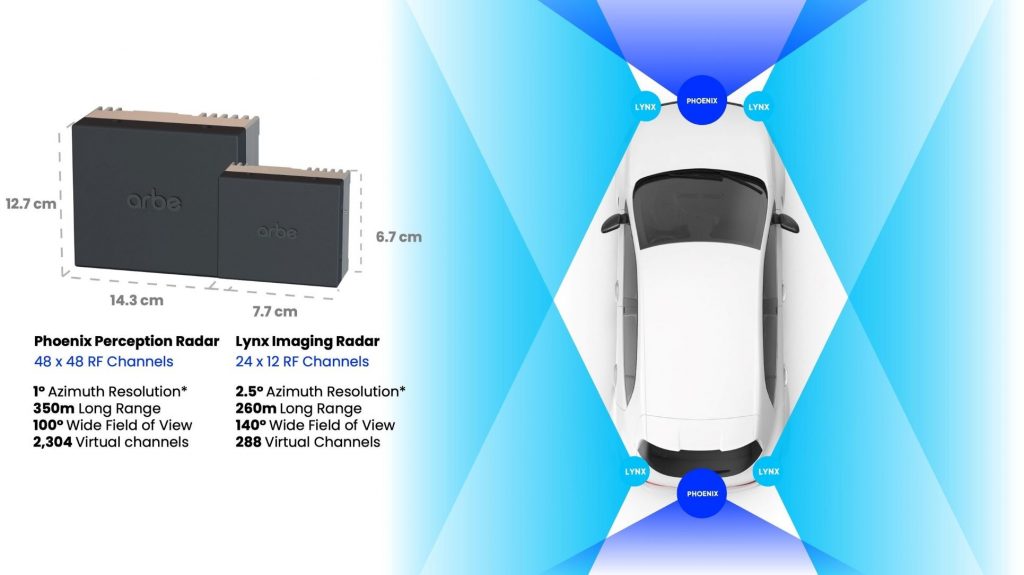
At CES 2023, Arbe Robotics Ltd. debuted its award-winning 360° radar-based perception system. The CES 2023 Innovation Awards Honoree from a record high number of over 2100 submissions.
Arbe’s system, which won in the category of Vehicle Intelligence & Transportation, processes highly detailed data captured by its long-range front, rear, and surround radars, using AI to identify, classify, and track surrounding objects for real-time analysis of the free space around the vehicle, as well as evolving hazards.
With high resolution in all dimensions and top performance in any weather or lighting conditions, the company aims to reposition radar to be the backbone of the autonomous and ADAS sensing suite, providing advanced safety for SAE Level 2+ and higher autonomy. The company says its solution democratizes safety and autonomous technology by making the most cutting-edge radar technology available at a price that is affordable for every vehicle—not exclusive to top-of-the-line luxury.
A key component of the new solution was Arbe’s July introduction of a surround imaging radar called Lynx. The company says that the radar, which processes 24×12 channels, is the only long-range, high-resolution, 360°-sensing, affordable solution available. It is said to outperform the current industry 3×4 corner radars, and even the most advanced 12×16 front radars, making it an industry-first surround radar able to enhance perception and sensor fusion.
The Lynx imaging radar’s small form factor and affordable price make it suitable for multiple installations around the vehicle. It was designed to complement the company’s flagship product, the Phoenix perception radar, which processes 48×48 channels. Both radars are designed to work in sync to deliver unified perception and interference avoidance, providing full sensor coverage around the vehicle and addressing the different requirements in each position for AVs (autonomous vehicles).
“For the first time, the industry is being introduced to surround imaging radar that enables true safety and the rollout of advanced autonomous applications,” said Kobi Marenko, CEO of Arbe, in July. “The launch of this new product represents a tremendous business opportunity for Arbe and for our Tier 1 partners.”
Company execs believe that the high demand for a long-range surround sensor represents a significant opportunity. To achieve true safety and autonomy, L2+ vehicles will require four to six surround imaging radars per vehicle, integrated on top of one or two perception radars.
Lynx is designed to be a corner and a back radar for L2+ and higher AVs and as a front radar for advanced driver assist systems (ADASs), a new industry vertical for imaging radars, comprising a vast number of vehicles. Several Tier 1 suppliers already implement Arbe-based surround imaging radars to offer OEMs a complete 360° solution that is future-proofed and ready for the next generation of perception requirements.
The company says that 360° sensing has been performed with corner radars, which were used primarily for ADAS features like blind-spot detection, cross-traffic alert, and tracking of dynamic objects. However, corner radars notoriously fell short in providing a solution for more challenging use cases like alerting about a vehicle approaching from a long distance, identifying stationary objects, detecting the distance between one vehicle and the next, and measuring object shape and size. Because corner radars do not provide imaging, they were not integrated with the other sensors in the vehicle for sensor fusion and did not contribute to the perception system.
Lynx resolves the sensor gap for surround installations by providing a solution to challenging lighting and weather conditions limiting cameras and LiDARs that also lack the needed long range. Corner radars cannot provide the needed redundancy to optical sensors because of their low resolution, and the high cost of the high-resolution long-range radars on the market makes them impractical to implement in multiple locations on a vehicle.
To fill this market gap, Arbe launched Lynx imaging radar as a reliable and affordable sensor that provides both redundancy and data diversity critical for both automotive-grade safety and for rolling out autonomous functionality. Lynx delivers effective sensing in all environment conditions and gathers the data that optical sensors lack, like velocity, long range, and depth perception.

